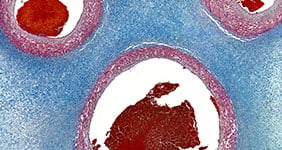Upstream sample preparation is crucial for the consistency and replicability of tissue analysis results. Traditional sample prep methods for tough tissues like umbilical cord samples can be time-consuming and yield inconsistent results.
Umbilical cord tissue is one of the toughest samples to homogenize for analysis. Still, it can yield invaluable information for the study of biomarkers present in the blood for a short period of time and for the assessment of newborn toxicology and genetic analysis.
From nucleic acid extraction to protein quantification and more, analysis of this tissue depends on the right homogenization process of tissue samples.
Traditional methods that include manual and chemical preparation – even the use of household blenders in some cases – pose drawbacks that can include inconsistent results, lengthy processing time, and a difficult cleaning job in the case of blenders.
UMBILICAL CORD CHALLENGES & APPLICATIONS
Among the challenges associated with preparing umbilical cord samples is the disruption of densely packed tissue into uniform and complete homogenates with consistent results and efficient throughput.
With the growing use of umbilical cord tissue for assessments that include intrauterine drug exposure and the regulation of key indicators for pregnancy-related conditions like pre-eclampsia and gestational diabetes, the traditional use of manual homogenization is not ideal for streamlined, efficient throughput.
High-powered tools, including hand-held tissue homogenizers with stainless steel and plastic probes and high-throughput models using bead-beating technology, are preferred over manual or chemical digestion methods.
FINDING THE RIGHT HOMOGENIZER FOR TOUGH TISSUE SAMPLES
For the preparation of human and animal tissue for analysis, homogenization is a critical first step in the sample’s analyte extraction.
Finding the right homogenizer for tissue sampling includes an assessment of multiple factors:
- Consistency: Does the homogenizer yield consistent results? Are the tissues reduced to a fine and uniform consistency?
- Method & Media: what is the most robust homogenization method for the type of samples to be processed? From the type of media to the motion used to disrupt the sample, homogenization methods tailored to the sample type are most effective.
- Cross Contamination: sample tubes should be sealed, separate, and disposable to reduce the risk of cross-contamination significantly. Homogenizing tools should eliminate or greatly reduce opportunities for contamination.
- Temperature: some methods of homogenization can heat the material as it is reduced to smaller particulates, which can compromise the sample. The right homogenizer is one that does not generate excessive heat in the process.
- Ease of Use: is the homogenizer user-friendly? Easy to clean? For tissue sampling, choosing one designed specifically for homogenizing biological samples is best.
- Capacity & Automation: depending on the number of samples to be processed and your requirements for through-put, large capacity homogenizers and programmable, walk-away automation can be a convenience or a requirement.
OMNI OPTIONS FOR UMBILICAL CORD SAMPLES
With decades of experience helping laboratory managers identify the right homogenization equipment and best practices for their needs, OMNI International’s team can help your laboratory find the right equipment and processes for preparing the most difficult-to-process samples, including umbilical cord tissue.
The OMNI Bead Ruptor Elite™ bead mill homogenizer is specifically designed for tissue homogenization and for preparing samples when extracting DNA, RNA, proteins, and small molecules. The homogenizer can quickly reduce tissue samples to a fine, consistent material with a convenient front-loading design, integrated lid-lock features, and no cool-down between runs.
The Bead Ruptor Elite™ bead mill has a broad force range and high impact forces for tough tissue samples, including umbilical cord and placental tissue. This model also includes unique tube carriage motion and bead material that improves the high lysing efficiency to increase both nucleic acid, protein, and small molecule yields and the sensitivity of the downstream assay.
Additional benefits include:
- Wide range of accessories for any sample size: 24 x 0.5 mL, 24 x 1.5 mL, 24 or 48 x 2 mL, 12 x 7 mL, 12 x 15 mL, 6 x 30 mL, and 3 x 50 mL
- New touchscreen interface: choose settings and walk away
- 99 programmable memory settings and multilingual user interface
The Omni THq Digital Handlheld Tissue Homogenizer is a lightweight, digital option that can also be used with a stand for fast homogenization of hard tissue. Disposable plastic homogenizer probes eliminate cross-contamination concerns, while stainless steel probes are available for larger or tougher sample types.
Other features include:
- Energy-efficient 40-watt motor
- Integrated Digital Speed Display and Controller for accurate, repeatable results
- Whisper Drive Technology ensures ultra-quiet operation (<65db)
- Compatible with patented OMNI Tip™ Plastic Probes and 10mm stainless steel generator probes
- Lightweight, ergonomic design
- Includes specially designed stand mount adapter
UMBILICAL CORD SAMPLE PREP APPLICATION NOTES
For more information about how OMNI homogenizers are used by labs for umbilical cord sample prep, read these application notes from our application library:
FINDING THE RIGHT TISSUE HOMOGENIZATION SOLUTION
Labs can reduce processing time with the right homogenizing solution while improving sample consistency.
OMNI’s selection of tissue homogenizers is designed for various specific applications across the medical, scientific, and pharmaceutical fields. Speak to one of our homogenizer experts to arrange for a complimentary demonstration of our equipment or to have our lab create a custom protocol for your application.

